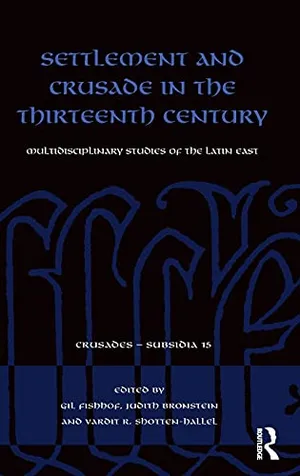Archaeologists in Israel Unearth Only Known Crusader Encampment
Frankish soldiers camped at the site before the 1187 Battle of Hattin, which ended in a decisive victory for Muslim sultan Saladin
:focal(607x493:608x494)/https://tf-cmsv2-smithsonianmag-media.s3.amazonaws.com/filer_public/84/cd/84cd504d-ab37-4448-827d-799ca1284fe5/coins.jpg)
On the eve of combat, Frankish Crusader knights broke camp near a spring in what is now Israel before moving into position to meet the Muslim armies of Saladin. The next day, July 4, 1187, the legendary sultan’s soldiers crushed these men and their European allies at the Battle of Hattin, paving the way for the end of Christian occupation of the Holy Land—and the eventual outbreak of the Third Crusade in 1189.
Now, archaeologists say they’ve located remnants of that Crusader camp—the first of its kind ever unearthed in the Middle East. As the Jerusalem Post’s Rossella Tercatin reports, the researchers also found a trove of artifacts that shows how Christian armies lived while they were in the field.
Published in the book Settlement and Crusade in the Thirteenth Century, the new findings shed light on the medieval encampment, which was discovered at the Zippori springs in Galilee during expansion of a local highway. Archaeologists Nimrod Getzov and Ianir Milevski of the Israel Antiquities Authority (IAA) conducted the excavation with assistance from Rafael Lewis, an archaeologist at the University of Haifa.
Settlement and Crusade in the Thirteenth Century
This book sheds new light on formerly less-explored aspects of the crusading movement and the Latin East during the 13th century.
“The area along Route 79 was known as the site of the Frankish encampment ahead of the Battle of Hattin in 1187, as well as for other encampments by both the Crusaders and the Muslims during a period of 125 years,” Lewis tells the Jerusalem Post.
He adds, “It was a very exceptional opportunity to study a medieval encampment and to understand their material culture and archaeology.”
Spanning the 11th through 13th centuries, the Crusades were a series of religious wars fought by European leaders and the Roman Catholic Church to wrest control of the Holy Land from Muslim rulers. Initially, the Crusaders succeeded and established several Christian states in the Levant, or eastern Mediterranean. But Muslim forces eventually regained control of the area, repelling multiple attempts to reconquer the region.
At Zippori, the archaeological team uncovered numerous metal artifacts dated to the time of the Kingdom of Jerusalem, which existed between 1099 and 1291, reports Ruth Schuster for Haaretz. These finds included coins, needles, arrowheads and objects used to care for horses: bridles, harness fittings, a currycomb, horseshoes, and horseshoe nails made both in Europe and closer to the campsite.
/https://tf-cmsv2-smithsonianmag-media.s3.amazonaws.com/filer_public/42/9e/429eca36-6a40-4924-9bfd-5781d5c9ba84/2887389424.jpeg)
“Changing those nails probably represented the main activity in the camp,” Lewis tells the Jerusalem Post. “Nobody wanted to find himself in the battle on a horse with a broken shoe.”
Archaeologists were surprised by the lack of everyday artifacts such as cooking pots. Lewis speculates that these materials were moved to castles and other fortifications after the encampments were no longer needed.
The team also discovered a large quantity of “aristocratic artifacts”—gilded buckles and hairpins, manufactured in the European style and likely used by knights and other elite members of the Crusader armies, per Haaretz. While these forces operated loosely under the command of the king of Jerusalem, each had its own leaders. This particular encampment would have been led by a Frankish king who probably camped on a mound overlooking the springs.
Interestingly, no stone or wooden structures built by Crusaders were found at the site (also known as the Springs of Saforie or Sepphoris), which was used by Roman troops a millennium prior and local populations before that.
/https://tf-cmsv2-smithsonianmag-media.s3.amazonaws.com/filer_public/8a/7a/8a7a2ffa-0a60-4d93-bc2f-bc948cebee07/2887389424.jpeg)
The medieval encampment’s legacy is that of impermanence, Lewis tells Haaretz. According to historical documents, Crusader knights lived in tents and were prepared to go into combat at a moment’s notice.
When exactly Christian armies first camped at the spring is unknown, but the site was used as a rallying point for troops as early as the 1130s, Haaretz reports. Lewis suggests the area was ultimately occupied by both Christian and Muslim forces.
The archaeologists are hopeful they will soon find other sites used by European armies during the Crusades. Lewis says such discoveries will add extensively to scholars’ knowledge of what happened in the Middle East during this tumultuous time.
“I’m intrigued to understand more about Crusader encampments,” he tells the Jerusalem Post. “I believe that the study of military camps has the potential to allow us to understand much more about the period and its culture.”
A Note to our Readers
Smithsonian magazine participates in affiliate link advertising programs. If you purchase an item through these links, we receive a commission.
/https://tf-cmsv2-smithsonianmag-media.s3.amazonaws.com/accounts/headshot/dave.png)

/https://tf-cmsv2-smithsonianmag-media.s3.amazonaws.com/accounts/headshot/dave.png)